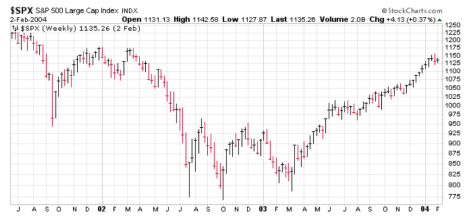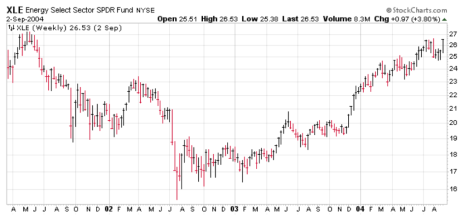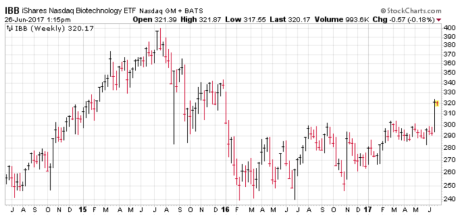After a long downturn, biotech stocks are suddenly at an 18-month high. Later, I will tell you exactly where to find the best biotech stocks. But first, let me show you how to identify the next sector (or stock) that’s about to wake from an extended slumber.
How to Identify “Buy Low” Points
No matter what’s going on in the market or the world, I’m pretty much guaranteed to get one email per week from a reader asking whether I think it’s a good idea to buy XYZ stock that’s been in the doghouse for many months (if not longer). Obviously, as a trend follower, I tend to dissuade these people from buying when a stock is hitting new lows.
[text_ad]
But it does pose the question: When is a good time to get into a fallen angel? Believe it or not, buy points aren’t hard to identify if you look at some long-term charts.
When is a Good Time to Buy Low?
The key to buying stocks that are in the doghouse comes down to one thing: after a big decline, bottoms take time to build. The big misconception is that you must get in early to make big money. But in reality, it’s just the opposite—you usually want to wait for a sturdy foundation to form, whether it’s the market as a whole, a sector or an individual stock.
For instance, let’s look at the market’s bottoming formation after the 2000-2003 bear move, when the S&P 500 lost 50% (and the Nasdaq imploded 78%). Who knows how many investors tried to pick a bottom during the multi-year decline, and they didn’t have to!
Notice how the S&P 500, after declining for two years, had a seven-month bottoming process—the index hit the 750 level three times (July 2002, October 2002 and March 2003) before the bulls finally took control. Bottoms are a process, not an event!
Now let’s look at the huge, generational-type bottom we saw in oil stocks in 2004. The SPDR Energy Fund (XLE) crashed with the market into July 2002, but except for a brief two-week bounce, didn’t do much until May 2003. But even that rally didn’t lead to much, with XLE spending another few months tightening up in a great-looking base—leading to the blastoff that November. The fund advanced nearly 300% during the next few years!
When looking for major bottoms after big declines, you generally want to see four things.
First, of course, is a big, extended decline. There are no set rules on how big the drop must be, but it’s usually at least 30%, and it should last at least a few months if not much longer—it must be enough to knock every weak hand out.
Second is a prolonged bottom-building effort. This will usually last at least half as long as the decline (if a stock fell for six months, the bottom should be at least three months, etc.), if not longer, and include a few false starts to frustrate the buyers. Support levels will generally hold, though there may be a brief probe or two below support to shake people out.
Third, toward the end of the bottoming process you’ll see some tightness, where there will basically be zero movement for a few weeks or more. This is a sign that eyes have completely come off the stock/sector/market, that all the weak hands are out and that supply will be limited once buyers come back to the market.
Fourth, you see a powerful blastoff, one that usually persists for at least two or three weeks, confirming there’s a vacuum of selling pressure and that a new uptrend has begun.
One Sector to Buy Now
We’ve seen just this type of setup in biotech stocks.
Looking at the chart, you can see that the iShares Biotech Fund (IBB) peaked in July 2015 after a huge run the prior three and a half years. The collapse took place over about seven months and sliced 40% off the sector.
Then came the bottoming process, with lots of ups and downs during the next 16 months, but the 240 level generally held on the downside, while upside was capped by the 300 area.
Third, note how IBB tightened up over about three months, especially in June.
Finally, we had last week’s liftoff, taking the fund to its highest levels since January 2016. It looks like the start of a new uptrend to me!
To take part in it, you could simply buy IBB or the SPDR S&P Biotech Fund (XBI), which is more diversified in its holdings. Both should do well if the group continues higher, as I expect.
The Best Biotech Stocks
But I think the leaders of the group—both big-cap and small-cap stocks—will do a lot better than the indexes in the new bull move. To learn the names of the best biotech stocks, you should take out a subscription to Cabot Top Ten Trader, where every week I screen for the market’s strongest leading stocks, and provide entry points (and loss limits in case something goes wrong!) on all of them. Quite simply, it’s the best source of new ideas out there, and the proof is in the fact that we have tons of money managers, hedge fund managers and brokers as subscribers!
If you want to stay on top of all the market’s leading growth stocks, including the best biotech stocks to own right now, grab a subscription to Cabot Top Ten Trader today.
[author_ad]



